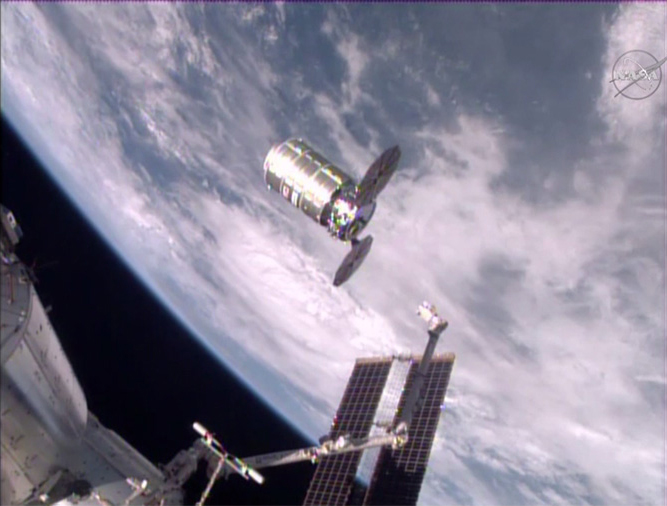Private Cygnus Cargo Ship Leaves Space Station to Meet Fiery Doom

Cygnus is ready to take the plunge: This morning (Feb. 19), at 7:26 a.m. EST (1226 GMT), the International Space Station's robotic arm released the latest Orbital ATK cargo ship into open space so the unmanned spacecraft can end its resupply mission with a death dive into Earth's atmosphere.
Once it is safely away from the station, the commercial Cygnus spacecraft will fire its engines twice to re-enter Earth's atmosphere and burn up over the Pacific Ocean.
The supply craft, named the S.S. Deke Slayton II, arrived at the space station in December, carrying more than 7,700 lbs. (3,500 kilograms) of cargo — the most ever carried in a Cygnus craft. It featured an expanded design that allowed it to carry about 25 percent more cargo than previously, and it was blasted upward by United Launch Alliance's Atlas V rocket. (This was the first Cygnus launch since the explosion of Orbital ATK's Antares rocket in October 2014.)
When it launched to the station, the supply craft carried several experiments, including a locker-size life sciences research module, an experiment for testing flame-resistant and flame-retardant textiles in microgravity, and two modular sets of microsatellites. Plus, the craft carried replacement parts for the space station and consumable supplies. (And it brought a student-made experiment aboard, featuring a medallion blessed by the Pope.)
The space station crew has spent the past few days filling the Cygnus spacecraft with trash before its departure, while also performing their normal experimental work in the orbiting lab.
The space station crewmembers are also preparing for another spacecraft departure: U.S. astronaut Scott Kelly and Russian cosmonauts Mikhail Kornienko and Sergey Volkov will leave in a Soyuz spacecraft March 1. At that time, Kelly and Kornienko will have just finished their nearly yearlong stay on the station. U.S. astronaut Tim Kopra, British astronaut Tim Peake and Russian cosmonaut Yuri Malenchenko will remain on board, and will be joined March 19 by U.S. astronaut Jeff Williams and Russian cosmonauts Oleg Skripochka and Alexey Ovchinin.
Email Sarah Lewin at slewin@space.com or follow her @SarahExplains. Follow us @Spacedotcom, Facebook and Google+. Original article on Space.com.
Breaking space news, the latest updates on rocket launches, skywatching events and more!

Sarah Lewin started writing for Space.com in June of 2015 as a Staff Writer and became Associate Editor in 2019 . Her work has been featured by Scientific American, IEEE Spectrum, Quanta Magazine, Wired, The Scientist, Science Friday and WGBH's Inside NOVA. Sarah has an MA from NYU's Science, Health and Environmental Reporting Program and an AB in mathematics from Brown University. When not writing, reading or thinking about space, Sarah enjoys musical theatre and mathematical papercraft. She is currently Assistant News Editor at Scientific American. You can follow her on Twitter @SarahExplains.
